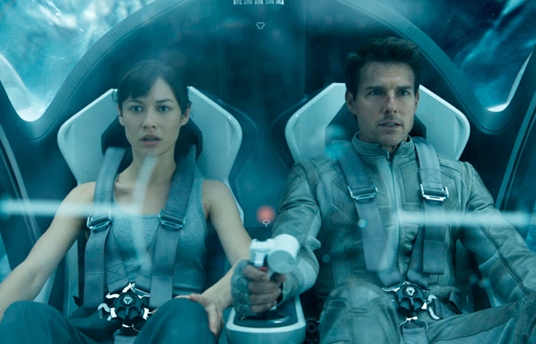Now Playing in Doha! : Oblivion
Apr 11, 2013

By Alexander Wood
Lovers of the post-apocalyptic genre might never expect an eviscerated Earth to look so stunning and aesthetically clean as it does in Joseph Kosinski’s ‘Oblivion’. The man behind the light-cycles, glowing digital landscapes, and the Daft Punk soundtrack of ‘Tron Legacy’ excels in sculpting his latest world, which weaves together shattered cityscapes with the perpetual craw of nature as it reclaims the lost civilisations of mankind.
We are introduced to our fallen world after a great war between humans and unknown invaders from outer space, which still scavenge on the Earth’s surface, slowly and methodically disabling the drones that ensure humankind’s safety. Jack (Tom Curise) and Victoria (Andrea Riseborough) are the mop-up crew tasked with killing the remaining alien life forms, while the rest of the human population relaxes in a manmade space station or on Titan, Saturn’s largest moon. Jack and Victoria are soon to be relieved of their post in a Frank Lloyd Wright-esque home in the clouds – which for any ‘Star Wars’ fan will be reminiscent of ‘Cloud City’– to return to the mother ship, where they will join other humans who are living an astronaut lifestyle. You guessed it: the prospect of Jack and Victoria’s imminent safety foreshadows the ominous occurrences that are about to go down.
The banal duties of repairing drones are shattered by a few interactions with the other side, altering Jack’s demeanour – and his view of the world around him. Black-and-white flashbacks of Jack on the Empire State Building and a mysterious woman persist, despite the mandatory memory wipe that was executed to ensure security from the enemy. Interactions with mission control and the triangular space station orbiting Earth all support the idea that still waters run deep – and that there is more here than meets the eye.
Based on the comic book of the same name, ‘Oblivion’ has a rich visual style and vast intertextuality that references works of literature – for example Macaulay’s ‘Lays of Ancient Rome’ and Dickens’s ‘Tale of Two Cities’– all of which invite viewers to peel back the surface meaning and peer underneath. Jack is constantly hiding his collection of books, which would be destroyed because of ‘contamination’. Ray Bradbury’s ‘Fahrenheit 451’, depicting a future where books are burnt, and George Orwell’s ‘1984’, which threatens the ever-watchful eye of Big Brother, are both alive in many scenes of the film –mirrored by the constant surveillance by drones and the destruction of cultural artifacts.
The diverse influences on the film contribute to its complex narrative, which allows viewers to discover much more than what is on screen. Stanley Kubrick’s ‘2001 Space Odyssey’ is one of the film’s greatest influences and his visual signature is echoed in the film’s final moments. (Those familiar with HAL and Dave’s rocky robotic relationship will see the end of the film coming – ‘Open the pod bay doors, HAL’; ‘I’m sorry, Dave. I’m afraid I can’t do that’.)
The beautiful set design and futuristic objects make it difficult to not be swept away in the world that Kosinski created in his comic book, then distilled on screen. The clean and captivating soundtrack, which harks back to ‘Tron Legacy’, can be found online for free, adding another level of awesome to an already great film.
Oblivion - Trailer
إعلان فيلم "النسيان"